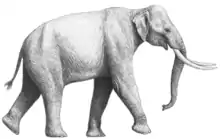Palaeoloxodon recki
Palaeoloxodon recki or Elephas recki is an extinct species of elephant native to Africa during the Pliocene and Pleistocene. At up to 14 feet (4.27 metres) in shoulder height, it was one of the largest elephant species to have ever lived. It is believed that P. recki ranged throughout Africa between 3.5 and 1 million years ago. P. recki was a successful grass-eating elephant until it became extinct, perhaps by competition with members of the genus Loxodonta, the African elephants of today. Its descendant taxon, "Elephas" jolensis persisted into the late Middle Pleistocene, c. 205-130 kya in Kenya, after which it was replaced by Loxodonta africana after a severe drought period.[1] P. recki is believed to be the ancestral species from which the Palaeoloxodon species of Eurasia are derived.[2]
| Palaeoloxodon recki Temporal range: Pliocene to Pleistocene | |
|---|---|
 | |
| cast of jaw, at Museum für Naturkunde, Berlin | |
| Scientific classification | |
| Kingdom: | Animalia |
| Phylum: | Chordata |
| Class: | Mammalia |
| Order: | Proboscidea |
| Family: | Elephantidae |
| Genus: | †Palaeoloxodon |
| Species: | †P. recki |
| Binomial name | |
| †Palaeoloxodon recki (Dietrich, 1894) | |
| Synonyms | |
|
Elephas recki | |
A male of P. recki from Koobi Fora was 40 years old when it died. At that age it was 4.27 metres (14.0 ft) tall and weighed 12.3 tonnes (12.1 long tons; 13.6 short tons).[3] The species is known from the Middle Atlas of Morocco.[4]
Subspecies

M. Beden [5][6][7] identified five subspecies of Palaeoloxodon recki, from oldest to youngest:
- P. r. brumpti Beden, 1980
- P. r. shungurensis Beden, 1980
- P. r. atavus Arambourg, 1947
- P. r. ileretensis Beden, 1987
- P. r. recki (Dietrich, 1916)
New research indicates that the ranges for all five subspecies overlap, and that they are not separated in time as previously proposed. The research also found a wide range of morphological variation, both between the supposed subspecies and between different specimens previously identified as belonging to the same subspecies. The degree of temporal and geographical overlap, along with the morphological variation in P. recki suggests that the relationships between any subspecies are more complicated than previously indicated.[8][9]
References
- Manthi, Fredrick Kyalo; Sanders, William J.; Plavcan, J. Michael; Cerling, Thure E.; Brown, Francis H. (September 2020). "Late Middle Pleistocene Elephants from Natodomeri, Kenya and the Disappearance of Elephas (Proboscidea, Mammalia) in Africa". Journal of Mammalian Evolution. 27 (3): 483–495. doi:10.1007/s10914-019-09474-9. ISSN 1064-7554.
- Lister, Adrian M. (2004), "Ecological Interactions of Elephantids in Pleistocene Eurasia", Human Paleoecology in the Levantine Corridor, Oxbow Books, pp. 53–60, ISBN 978-1-78570-965-4, retrieved 2020-04-14
- Larramendi, A. (2016). "Shoulder height, body mass and shape of proboscideans" (PDF). Acta Palaeontologica Polonica. 61. doi:10.4202/app.00136.2014.
- Marinheiro, J., Mateus, O., Alaoui, A., Amani, F., Nami, M., & Ribeiro, C. (2014). New Quaternary fossil sites from the Middle Atlas of Morocco. Comunicações Geológicas, 101(Especial I), 485-488.
- Beden, M. 1980. Elephas recki Dietrich, 1915 (Proboscidea, Elephantidae). Èvolution au cours du Plio-Pléistocène en Afrique orientale]. Geobios 13(6): 891-901. Lyon.
- Beden, M. 1983. Family Elephantidae. In J. M. Harris (ed.), Koobi Fora Research Project. Vol. 2. The fossil Ungulates: Proboscidea, Perissodactyla, and Suidae: 40-129. Oxford: Clarendon Press.
- Beden, M. 1987. Les faunes Plio-Pléistocène de la basse vallée de l’Omo (Éthiopie), Vol. 2: Les Eléphantidés (Mammalia-Proboscidea) (directed by Y. Coppens and F. C. Howell): 1-162. Cahiers de Paléontologie-Travaux de Paléontologie est-africaine. Centre National de la Recherche Scientifique (CNRS). Paris.
- Todd, N. E. 2001. African Elephas recki: Time, space and taxonomy. In: Cavarretta, G., P. Gioia, M. Mussi, and M. R. Palombo. The World of Elephants, Proceedings of the 1st International Congress. Consiglio Nazionale delle Ricerche. Rome, Italy. Online pdf Archived 2008-12-16 at the Wayback Machine
- Todd, N. E. 2005. Reanalysis of African Elephas recki: implications for time, space and taxonomy. Quaternary International 126-128:65-72.